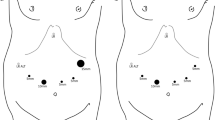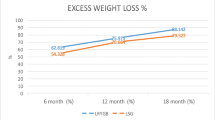Abstract
Background
Although long-term data have been published on the complications after laparoscopic Roux-en-Y gastric bypass (LRYGB), laparoscopic sleeve gastrectomy (LSG) is a relatively new procedure without a well-established long-term procedure-related morbidity profile. Our aim was to compare the 6-year data on re-operations occurring after and related to LRYGB versus LSG at a large academic bariatric center.
Methods
Retrospective review of all the bariatric procedures at the Massachusetts General Hospital between 2009 and 2014.
Results
A total of 934 LRYGB and 553 LSG were performed. There were no significant differences in the gender, age, or BMI of the patients at the time of their index operations (p > 0.05 for all). A higher percentage of LRYGB patients required cholecystectomy as compared to LSG patients (5 vs. 2 %, X 2 = 8.63, p < 0.01). There was also a significant difference in the proportion of patients requiring re-operations for other reasons following LRYGB as compared to LSG (6.9 vs. 0.9 %, X 2 = 27.8, p < 0.01). A total of 32.8 % of these bypass patients underwent more than one re-operation, with a relative risk of 11.5 (95 % CI 4.69–28.5) as compared to those undergoing SG. A total of 9.3 % of secondary operations occurred at a mean of 1 month after the LRYGB for functional obstruction, with most of these cases related to a technical error. Other re-operations occurred in a delayed fashion, without a clearly identifiable intra-abdominal source in 22.2 %, due to adhesive bowel obstruction in 17.6 %, and internal hernia in 15.7 %. Non-healing ulcers and intussusception were responsible for a small percentage of re-operations (3.7 and 2.8 %).
Conclusions
SG is associated with a relatively low rate of re-operations, while patients after LRYGB are at a significant long-term risk for multiple operative procedures.

Similar content being viewed by others
References
Sjostrom L et al (2007) Effects of bariatric surgery on mortality in Swedish obese subjects. N Engl J Med 357(8):741–752
Sjostrom L et al (2004) Lifestyle, diabetes, and cardiovascular risk factors 10 years after bariatric surgery. N Engl J Med 351(26):2683–2693
Schauer PR et al (2014) Bariatric surgery versus intensive medical therapy for diabetes–3-year outcomes. N Engl J Med 370(21):2002–2013
Hutter MM et al (2011) First report from the American College of Surgeons Bariatric Surgery Center Network: laparoscopic sleeve gastrectomy has morbidity and effectiveness positioned between the band and the bypass. Ann Surg 254(3):410–420 (discussion 420-2)
Peterli R et al (2013) Early results of the Swiss Multicentre Bypass or Sleeve Study (SM-BOSS): a prospective randomized trial comparing laparoscopic sleeve gastrectomy and Roux-en-Y gastric bypass. Ann Surg 258(5):690–694 (discussion 695)
Kehagias I et al (2011) Randomized clinical trial of laparoscopic Roux-en-Y gastric bypass versus laparoscopic sleeve gastrectomy for the management of patients with BMI < 50 kg/m2. Obes Surg 21(11):1650–1656
Kruger RS et al (2014) A bariatric surgery center of excellence: operative trends and long-term outcomes. J Am Coll Surg 218(6):1163–1174
O’Brien PE et al (2013) Long-term outcomes after bariatric surgery: fifteen-year follow-up of adjustable gastric banding and a systematic review of the bariatric surgical literature. Ann Surg 257(1):87–94
Silecchia G et al (2008) Reoperation after laparoscopic adjustable gastric banding: analysis of a cohort of 500 patients with long-term follow-up. Surg Obes Relat Dis 4(3):430–436
Buchwald H et al (2004) Bariatric surgery: a systematic review and meta-analysis. JAMA 292(14):1724–1737
Chang SH et al (2014) The effectiveness and risks of bariatric surgery: an updated systematic review and meta-analysis, 2003–2012. JAMA Surg 149(3):275–287
Fridman A et al (2013) Procedure-related morbidity in bariatric surgery: a retrospective short- and mid-term follow-up of a single institution of the American College of Surgeons Bariatric Surgery Centers of Excellence. J Am Coll Surg 217(4):614–620
Vidal P et al (2013) Laparoscopic gastric bypass versus laparoscopic sleeve gastrectomy as a definitive surgical procedure for morbid obesity. Mid-term results. Obes Surg 23(3):292–299
Young MT, Gebhart A, Phelan MJ, Nguyen NT (2015) Use and outcomes of laparoscopic sleeve gastrectomy vs laparoscopic gastric bypass: analysis of the American college of surgeons NSQIP. J Am Coll Surg 220(5):880–885
Choi YY et al (2012) Reinforcing the staple line during laparoscopic sleeve gastrectomy: does it have advantages? A meta anal Obes Surg 22(8):1206–1213
D’Ugo S et al (2014) Comparative use of different techniques for leak and bleeding prevention during laparoscopic sleeve gastrectomy: a multicenter study. Surg Obes Relat Dis 10(3):450–454
Simon TE et al (2011) Comparison of staple-line leakage and hemorrhage in patients undergoing laparoscopic sleeve gastrectomy with or without Seamguard. Am Surg 77(12):1665–1668
Barreto TW et al (2015) A comparison of a single center’s experience with three staple line reinforcement techniques in 1502 laparoscopic sleeve gastrectomy patients. Obes Surg 25(3):418–422
Sroka G, et al (2015) Minimizing hemorrhagic complications in laparoscopic sleeve gastrectomy-a randomized controlled trial. Obes Surg
Sakran N et al (2013) Gastric leaks after sleeve gastrectomy: a multicenter experience with 2834 patients. Surg Endosc 27(1):240–245 (ix)
Brethauer SA (2011) Sleeve gastrectomy. Surg Clin North Am 91(6):1265–1279
Moszkowicz D et al (2013) Sleeve gastrectomy severe complications: is it always a reasonable surgical option? Obes Surg 23(5):676–686
Author information
Authors and Affiliations
Corresponding authors
Ethics declarations
Disclosures
Drs. Yulia Zak, Emil Petrusa, and Denise W. Gee have no conflicts of interest or financial ties to disclose.
Rights and permissions
About this article
Cite this article
Zak, Y., Petrusa, E. & Gee, D.W. Laparoscopic Roux-en-Y gastric bypass patients have an increased lifetime risk of repeat operations when compared to laparoscopic sleeve gastrectomy patients. Surg Endosc 30, 1833–1838 (2016). https://doi.org/10.1007/s00464-015-4466-5
Received:
Accepted:
Published:
Issue Date:
DOI: https://doi.org/10.1007/s00464-015-4466-5




